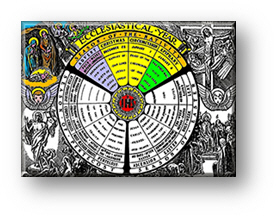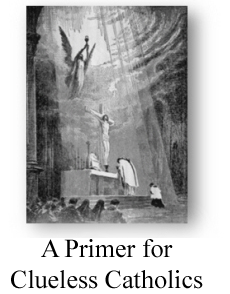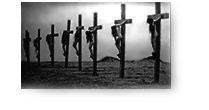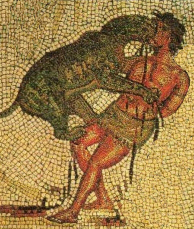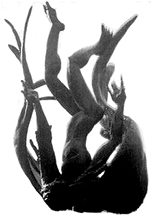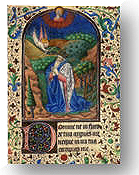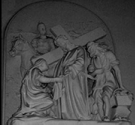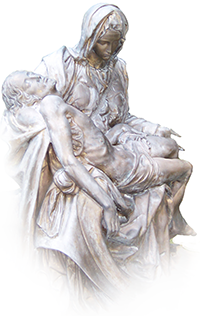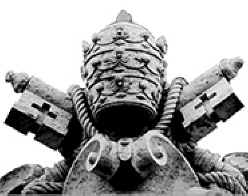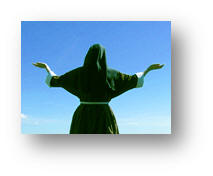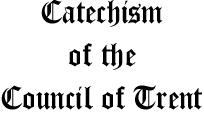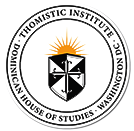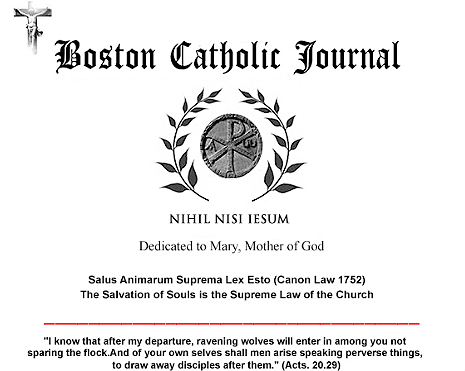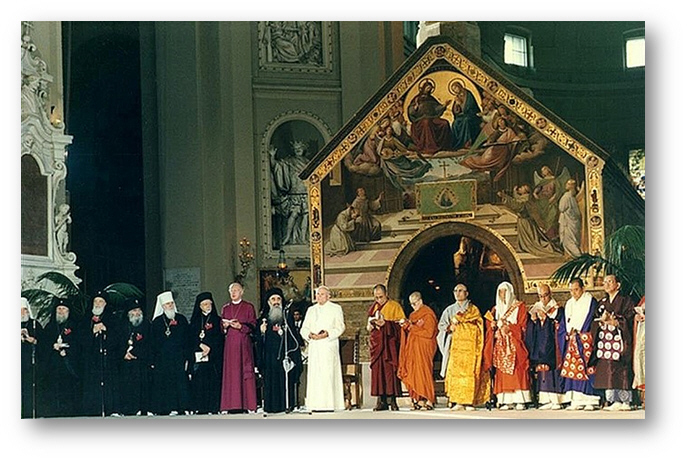|
“Who is GOD?”
|
| “I would like to emphasize that: today, for a Christian, it is not possible or practicable to go alone with one’s own denomination. Either we go together, all the fraternal denominations, or we do not go ahead at all. … Alone, never. We cannot do it. … Today, either we all walk together or we do not walk” |
This is Francis. This is also madness. It is heresy, and possibly apostasy. It is unquestionably contrary to the Catholic Faith as it has been known, understood, and practiced for the two millennia preceding that calamitous Council we call Vatican II, and the disastrous “oracle” of Francis within the Church.
The preceding citation is an affront, not only to Traditional Catholics, but to the universal human capacity to reason and understand in coherent and consistent terms. In Ecumenism we confront the illogical, the emotive, the intractable unwillingness to engage in anything construed as possibly inimical to its own peculiar agendum. Any attempt to invoke the canons of reason are understood as a threat to the Ecumenical Project.
For this reason, we insist that Francis is not simply the culmination, but the personification of the failed logic of that malignant enterprise — a pantheistic project, really — benignly dubbed “Ecumenism.” Since Vatican II, reason, logic, and revelation have been effectively abolished. Ecumenism — not Christ — is the ne plus ultra, the summit of every religious aspiration and impulse.
Who is the True God?
We see this clearly in the three “Inter-Faith-Assemblies” initiated by three successive popes in Assisi: John Paul II on Oct. 26, 1986, “To be together to pray.” Then on January 2002 his next pan-religious prayer meeting in the same venue. This was to be followed by Benedict XVI’s “Meeting for peace” on October 27, 2011, and then Francis’s “Day of prayer for peace” in Assisi, Italy, Sept. 20, 2016).
On these occasions, the absence of certainty concerning The One, True, God was the sine qua non of the merest possibility of Ecumenism.
Praying to Islam’s Allah, Shinto’s Kami, Hindu’s Trimurti, the Zoroastrian Ahura Mazdā, the African animist’s snake god Dan, or the Buddhist’s Dali Lama (who possesses no fewer than 108 “avatars”), was — in a quite uncertain way — praying to the same god in a kind of iridescent cope.
Each iteration of “god” was respectively acclaimed the certain god, even while it was impossible to reconcile all the alternating perceptions and contradictions inherent in those claims.
The Catholics were the only faction in the pantheon of contradictory gods who, through their pontifex Maximus Francis, conceded that they, at least, were uncertain; in fact, quite uncertain about the identity of the true “god,” and held the least tenable position of all: that the contradictions were only, and ultimately, illusory in the ecumenical schema. Those brazen enough to insinuate the faculty of reason into the ecumenical paradox and who raised the objection that the contradictions were real— both baffled and infuriated the “progressive” Catholic ecumenist who could, of course, resolve these otherwise insuperable issues in the snap of a chat. It is a strange, recursive world completely apart from the world of men. And its epicenter is the Vatican.
It is a world that expropriates madness from the narrow halls of the insane asylum, not only as emblematic of, but necessary to, the absurdity encountered at every level of “higher authority” and “higher learning” within the Church — and most especially the Vatican and Francis-as-pope.
This mantra — “the certainty of uncertainty (except the irrational notion of the uncertainty of certainty …)” — appears to verge on something intelligible … until one examines it more closely:
|
“Of this alone are we certain: the certainty of the uncertain — except, of course. the certainty of uncertainty … for of this we are quite certain” |
The religious epicenter of
this mental illness, as we have said, is the post-Catholic
Vatican — and its primary sponsor — and vector — Francis,
who infects with faux Jesuitical casuistry, everyone in
proximity to him. As such, Francis is indeed the pathogen
of this devastating disease that manifests itself in “certain
uncertainty.”
Ambiguity, we must understand, is the first symptom: state
nothing with unimpeachable certainty, and never in unambiguous
terms that possess the insolence of exactitude, that is
to say, apodictic (or absolute) certainty is the first organ
infected. It then advances through meaningless neologisms
which sound meaningful to the dull-witted — until they are
rationally examined by uninfected minds and reveal themselves
as so much drivel, or unembellished nonsense. But let us
allow Francis, a heretic, a Modernist, and the apex of evil
in the Vatican, to prove our point:
|
• “A first principle for progress in building a people:
time is greater than space.” |
Unless you are the keeper of, or an inhabitant within, an insane asylum, such “Analects from Chairman Francis” would be impossible to parse in rational terms, let alone attain to something meaningful, or, for that matter, coherent.
Once this ambitious policy of ambiguity and uncertainty infests
the offices and bookshelves of every seminary rector, pseudo-scholar,
and all the “carefully groomed” future priests in virtually
every Catholic seminary — it entirely suppresses and then
ruthlessly supersedes (but can never abolish) the 2000-year-patrimony
and the indefeasible competency of the quite certain Magisterium
of 2000 years. Together with the equally certain Sacred
Deposit of Faith, and Holy Tradition, which it contemptuously
disdains, it strives to replace all three with both spurious
and meretricious parodies — none of which possess “certainty.”
“Pink Palaces”
There is a desperate, decisive, and crucial need to return to sanity — and with sanity, certainty — through a complete reversion of all things to what is and ever was genuinely and unapologetically Catholic. This entails everything that has been blighted or obliterated since Vatican II, most especially a specifically numinous and universal language crafted for divine worship — Latin — which is unchanging and unchangeable and hence in no need of meaningless improvisations, no geographic or cultural inflections; it is a language that — for two millennia — was not confined to time and place; it transcended all geographical borders, all cultures and every age, attaining to universality in a way that no other language ever accomplished.
The return to sanity must embrace all that has been corrupted: everything religious, liturgical, intellectual, devotional, musical, every rubric, every response, enunciated without ambiguity — everything must be restored to the 2000-year-old form preceding the sacrilege of Vatican II. Apart from this total return, we remain a Church without reason in both its meanings: irrational and without purpose.
This cannot be achieved by schism from — but reversion to the One, True, Holy, Catholic Church of our forebears for two millennia — and apart from which (as the Church had constantly and tenaciously held until Vatican II) there is no salvation. She is the Body of Christ of which He is the head, and “there is no other Name [or god, or goddess, or pagan idol] by which we are saved” (Acts 4.12) except Christ Jesus.
Our hot-bed-homosexual seminaries, rectors, liberal and disaffected “teachers”; our “carefully groomed” pederast, pedophile, and predatory priests must first be immediately and unceremoniously thrown out, and the buildings they partied in and “co-occupied” must be thoroughly fumigated from the sexual filth that has found fertile ground there, much as a bacterium in a petri dish. They must be reassessed and reformed in stringently Catholic terms that tolerate no aberration. The spectacle of feminist ideologues (both female and male) instructing Catholic men on how to become priests must be put to an end and never allowed to experimentally emerge again. That is madness! Imagine laymen instructing women Religious postulants on how to become contemplative, cloistered nuns! In what venue would that occur? In a papally enclosed monastery? A Convent? Impossible! “Steel sharpens steel,” as it is said, and manly men should be examples in the classrooms and elsewhere to forge men for a manly task. The priesthood is nothing less.
“Certain” ... “feelings”?
The notion of certainty is both epistemological and invariable. The notion of feelings is both emotional and variable. The two are entirely separate. “Certainties” pertain to universally accepted definitions that cannot be contravened without contradiction. Anything less would be mere opinion. “Emotion” and “feelings, on the other hand, can consistently be contradictory. They are not confined by reason or any other objective constraint.
My emotional “feelings” are
different from your “feelings” but my cognitive understanding,
say, of a triangle must correspond to, and be in agreement
with, your understanding of a triangle: there is absolutely
no latitude, or alternative definition: “The sum of the
three interior angles comprising a triangle will always
— without exception — equal 180 degrees.” That absolute
certainty may not please you, but you cannot possibly make
it otherwise. You can state that it has 120 degrees, but
simply stating it will not make it so.
What we have Lost
Everything — everything we held dear and precious to us, everything distinguishable as uniquely Catholic — everything held sacred to us as Catholics has been has been torn from us by those who deem themselves “intellectually superior,” “aligned with the social issues of our times,” “more “enlightened,” “progressive,” “liberal,” and fashionably “dissident.” Understand that these are both subjective and subversive credentials.
Virtually every aspect of genuine, historical, Catholicism has been thrown under the feet of Modernists: the avant-garde (that is to say, the increasingly Protestant) cardinals, bishops, theologians, and “liturgists” — together with the “ever-experimental” priests incardinated by apex homosexual predators with an impenetrable network of homosexual advocates both inside and outside the Church. We absolutely must remember Christ’s admonition: “Do not give what is holy to the dogs; nor cast your pearls before swine, lest they trample them under their feet, and turn and tear you in pieces.” (Mat.7.6)
Every traditional Catholic understands the force behind this admonition. It is not simply marginalization, exclusion, and ridicule — but open hostility. Calvinists, Lutherans, animists, atheists, or pagans are much more likely to encounter a warm and welcoming reception from “progressives” in the Church than a traditional Catholic. Why? Because a traditional Catholics are in possession of a certainty foreign to their “progressive” counterparts — and central to that certainty is Jesus Christ Who is largely ignored in “ecumenical gatherings” as an impediment to Francis’s program of “Accompaniment” with all men, and all gods, and under all conditions.
Christ sometimes spoke analogically, but for the greater part of His (that is to say, God’s) discourses or simple utterances, He spoke with forceful clarity, unmitigated austerity, and absolute unambiguity. There was no misunderstanding Christ — or St. Peter, St. Paul, St. John, or any of the Apostles. No effort was made to accommodate the “sensitivities” of men, or the antagonism of the world. As St. Peter succinctly stated, regardless of consequence, “We ought to obey God, rather than men.” (Acts 5.29)
Contradictions Cannot be Politely Put Aside
Judge for yourself: if the absence of certainty is not ineluctably the absence of Christ — and of what He taught, what He commanded, and what He mandated for all who presume to follow in His footsteps — we have no warrant, no reason whatever, to appeal to what is uncertain — and being uncertain, inconsequential.
The corruption, estrangement, and ultimately the rescission of central aspects of Catholicism by Vatican II to accommodate non-Catholic “denominations” (Lutheranism in particular, Protestantism at large, and increasingly other “practices” it factitiously subsumes under the concept of “religion”) must be recognized, confronted, and not simply “resisted” — but actively challenged in the tribunal of reason and demonstrated to be wanting. Contradictions cannot be politely put aside to simply accommodate consensus. The very notion of contradiction denotes conflict and disagreement. We must remember that the Church has consistently taught and maintained that the relationship between Faith and Reason is both mutual and reciprocal — not contradictory. It is both doxastic and evidentiary, and so understood, the one involves the other.
It is on these grounds that the documents and propositions — however much subversively presented as “practical” in nature — that issued from Vatican should be decided. If they do not accord with reason (especially the Law of non-Contradiction), then neither are they consistent with Faith, specifically the Catholic Faith. We must soberly ask, “Do they accord with the Mens Ecclesiae” (the Mind of the Church”) distilled and meticulously articulated through the two-thousand years preceding “the Council” which has sought to mitigate the stringency of those teachings (for example, Nostra Aetate, otherwise known as the “Declaration on the Relation of the Church with Non-Christian Religions”, and Gaudium et Spes, the “Pastoral” Constitution on the Church in the Modern World— which seeks the engagement of the Church in “the world,” through a pastoral “activism” much along the lines of the social and political activism that became prominent in the 1960s and 1970s. No longer obsessed with issues eternal (such as the salvation of souls), she was called away from them by Gaudium et Spes to what it deemed more immediate and practical issues, issues concerning the social and political dimensions of man to the end of improving the secular world — now firmly in her embrace.
Here we would do well to pause here and to remember that these documents, among many more, are pastoral in nature, — not dogmatic — and unlike dogmas which are divinely revealed, infallible, and binding on all believers, whatever the nature of their authority, they are still open to being reformed, that is to say, revised and changed. They are not dogma which, by definition, is irreformable or unable to be changed. Since nothing infallible accrues to these teachings (nor is held to), then they are, indeed, subject to the criteria of reason and competent to stand before the Tribunal of Reason. We must then ask, do these pastoral documents accord with the canons of reason such that no contradiction is implied between these documents and the constant teaching of the Church prior to Vatican II? If no contradiction obtains, then the Council had done well. If not — and contradictions exist — they must be reconciled, or failing that, the teachings abandoned.
But where could such a forum be convened? Rome, of course. And convoked by whom? A pope, of course — which means that such a convocation will likely not occur within the lifetime of any present cardinal created by Francis or either of his two predecessors. They have been too thoroughly indoctrinated with Ecumenism to make such a leap into reason and logic.
Outposts of Sanity in an Ecumenical Wilderness
For this reason, it is vital for us, in the meanwhile, to find a Traditional Catholic Church where the Holy Sacrifice of the Mass is celebrated in Latin and according to the long-established rubrics prior to 1962 and the outrage that the post-Catholic-Conciliar-church imposed upon us and our children. Wherever the Latin Mass is celebrated, it is an outpost of sanity in a wilderness of ecclesiastical and liturgical madness.
In a very practical aside, when we “support” your local Novus Ordo church or when we donate to every diocesan plea for money, we must recognize that we are paying, at least in part (perhaps in large part), for the exorbitant fees of lawyers hired by the diocese to settle lawsuits against homosexual-predator-priests. Entire dioceses around the country have been bankrupted as a result. What is more, much of that (your) money is sent to the Vatican in billions of dollars used for countless capital ventures having absolutely nothing to do with alleviating the condition of “the poor” or “evangelizing non-Catholics in poor nations; rather, it is used to sponsor films like “Rocket Man,” a bio of the openly homosexual Elton John, to the tune of $4.5 million USD, in what the Daily Beast describes as,
| “Elton John’s rather steamy biopic Rocketman, which portrays the entertainer’s drug problems and is the first studio movie to portray gay sex between men in an authentic way.” |
Or, it may go to totally secular real-estate deals such as the €350 million investment in a luxury London real estate venture. Because of a blatant lack of transparency or accountability, your donation may simply be used in money-laundering for gangsters.
On the other hand, it may have gone to building the $2.2 million Tudor mansion by LBGT-friendly Atlanta Archbishop Wilton Gregory (now the cardinal of Washington, D.C.), or Newark New Jersey's Archbishop John Myers whose archdiocese spent $500,000 “to expand his retirement home, adding an indoor therapy pool, fireplaces and an office library.
It is not only American Catholics who are getting fleeced: German bishop Franz-Peter Tebartz-van Elst spent $43 million on a new residence and related renovations, including a 5-foot-deep fish tank, filled with Koi carpfish, at a cost of $300,000.
Is this really where you want your very hard-earned money to go? Of course not! — but it routinely does.
Refuse to legitimize this travesty. As we encouraged you earlier, find a Traditional Catholic Church not associated with the religious and financial scam that the Vatican has become since that tragic Council in 1962 — the year when the children sold their Mother into shame.
A Lingering Question
Should we, then, dismiss Novus Ordo Catholics? No! The great majority of them do not know — for they were never taught — the most basic concepts and tenets of genuine Catholicism, let alone proper comportment and apparel at Mass (which, for all appearances, is not a free-for-all for every religious impulse and expression). The blame lays squarely on the narrow shoulders of their “bishops” who never exercised oversight or authority over their priests — and their priests who never assured the proper catechesis of their flocks.
Let us be frank, for the past 60 years Catechesis essentially became crayons and insipid but expensive glossy books with not so much as a crease in their bindings. Most Catholic Masses remain effectively Protestant in tenor, presentation, architecture, statuary, stained-glass, Marty Haugen (not a Catholic) music and “I’m okay, you’re okay” homilies geared to the brainless.
This is not to impugn the piety of the aging congregation who — in the absence of proper and authentic Catechesis — never took the time to examine the unimpeachable credentials of their own religion, or even its differentiation from every other religion.
Despite the ignorance (understood in its actual definition as “a lack of knowledge, an absence of information”) of doctrine and dogma that we almost universally encounter in the post-Vatican II church, it is vital to us, as traditional Catholics, to understand — and answer — two essential points of confusion:
Does this mean that the Eucharist confected by a Novus Ordo priest at a Novus Ordo Mass is not Sacramentally valid?
No. It is still the Holy Eucharist, providing that the priest “does what the Church does.” This is a very real and canonically explicit imperative:
| “The Council of Trent does not mention the purpose of the sacrament or say that the minister ought to intend to do what the Church intends but what the Church does. Moreover, what the Church does refers to the action, not the purpose. There is required the intention with regard to the action, not in so far as it is a natural action, but in so far as it is a sacred action or ceremony, which Christ instituted or Christians’ practice. If one intends to perform the ceremony which the Church performs, that is enough.” (St. Robert Bellarmine, de Sacramentis in genere, chapter 27) |
Despite the ignorance — understood in its actual definition as “a lack of knowledge, an absence of information” — of doctrine and dogma that we almost universally encounter in the post-Vatican II church, it is vital to us, as traditional Catholics cleaving to the Faith for which the Martyrs and Saints bled and died, to remember that we should be paradigms of humility … keenly aware of our own abject state before God, recalling the admonishment of St. Paul in 1 Cor. 9.27 that we beware of any presumption of holiness within us:
“lest perhaps, when we have preached to others, we ourselves should become lost.”
But we must not and will not call evil good, nor good evil … however much we are called to do so by those who should be calling us away from every scandal of sin, but do not … for we must not and will not compromise with deceit …. crucifying Truth anew.
Geoffrey K. Mondello
Editor
editor@boston-catholic-journal.com
Boston Catholic Journal
www.boston-catholic-journal.com
![]() Printable PDF Version
Printable PDF Version
Comments? Write us:
editor@boston-catholic-journal.com
________________________
1
John18.38
2
Acts 4.12
3
See
Quotations from Chairman Francis
Totally Faithful to the Sacred
Deposit of Faith entrusted to the Holy See in Rome
“Scio
opera tua ... quia modicum habes virtutem, et servasti verbum
Meum, nec non negasti Nomen Meum”
Copyright © 2004
- 2024 Boston Catholic Journal. All rights reserved. Unless
otherwise stated, permission is granted by the Boston Catholic
Journal for the copying and distribution of the articles
and audio files under the following conditions: No
additions, deletions, or changes are to be made to the text
or audio files in any way, and the copies may not be sold
for a profit. In the reproduction, in any format of any
image, graphic, text, or audio file, attribution must be
given to the Boston Catholic Journal. |

